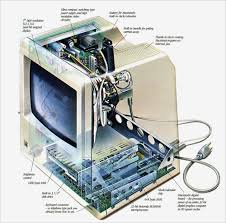In computer science, a data structure is a particular way of storing and organizing data in a computer so that it can be used efficiently.[1][2]

Data structures are used in almost every program or software system. Specific data structures are essential ingredients of many efficient algorithms, and make possible the management of huge amounts of data, such as large databases and internet indexing services. Some formal design methods and programming languages emphasize data structures, rather than algorithms, as the key organizing factor in software design.

Contents[hide]
|
[edit] Basic principles
Data structures are generally based on the ability of a computer to fetch and store data at any place in its memory, specified by an address — a bit string that can be itself stored in memory and manipulated by the program. Thus the record and array data structures are based on computing the addresses of data items with arithmetic operations; while the linked data structures are based on storing addresses of data items within the structure itself. Many data structures use both principles, sometimes combined in non-trivial ways (as in XOR linking).
[edit] Abstract data structures
The implementation of a data structure usually requires writing a set of procedures that create and manipulate instances of that structure. The efficiency of a data structure cannot be analyzed separately from those operations.
This observation moves the theoretical concept of an abstract data type, a data structure that is defined indirectly by the operations that may be performed on it, and the mathematical properties of those operations (including their space and time cost).
[edit] Language support
Assembly languages and some low-level languages such as BCPL generally lack support for data structures. Many high-level programming languages, on the other hand, have special syntax or other built-in support for certain data structures, such as vectors (one-dimensional arrays) in the C programming language, multi-dimensional arrays in Pascal, linked lists in Common Lisp, and hash tables in Perl. Many languages also provide basic facilities such as references and the definition record data types, that programmers can use to build arbitrarily complex structures.
Most programming languages feature some sort of library mechanism that allows data structure implementations to be reused by different programs. Modern programming languages usually come with standard libraries that implement the most common data structures. Examples are the C++ Standard Template Library, the Java Collections Framework, and Microsoft's .NET Framework.
Modern languages also generally support modular programming, the separation between the interface of a library module and its implementation. Some provide opaque data types that allow clients to hide implementation details and pictures. Object-oriented programming languages, such as C++ and Java, use classes for this purpose.
With the advent of multi-core processors, many known data structures have concurrent versions that allow multiple computing threads to access the data structure simultaneously.
[edit] See also
| Book:Data structures | |
| Books are collections of articles which can be downloaded or ordered in print. | |
- Concurrent data structure
- Parallel data structure
- Linked data structure
- List of data structures
- Comparison of data structures
- Data model
- Data modeling
- Dynamization
- Persistent data structure
[edit] References
- ^ Paul E. Black (ed.), entry for data structure in Dictionary of Algorithms and Data Structures. U.S. National Institute of Standards and Technology. 15 December 2004. Online version Accessed 2009-05-21.
- ^ Entry data structure in the Encyclopædia Britannica (2009) Online entry accessed on 2009-05-21.
- Niklaus Wirth, Algorithms and Data Structures
- Donald Knuth, The Art of Computer Programming, vol. 1. Addison-Wesley.
- Bill Viola, Will There Be Condominiums in Data Space?
- Dinesh Metha and Sartaj Sahni Handbook of Data Structures and Applications, Chapman and Hall/CRC Press, 2007.
[edit] External links
- Descriptions from the Dictionary of Algorithms and Data Structures
- http://www.cse.unr.edu/~bebis/CS308/
- Data structures course with animations
- data structure tutorials with animations
- An Examination of Data Structures
- CollectionSpy — A profiler and viewer for Java's standard data structure classes (see Java Collections Framework)
No comments:
Post a Comment